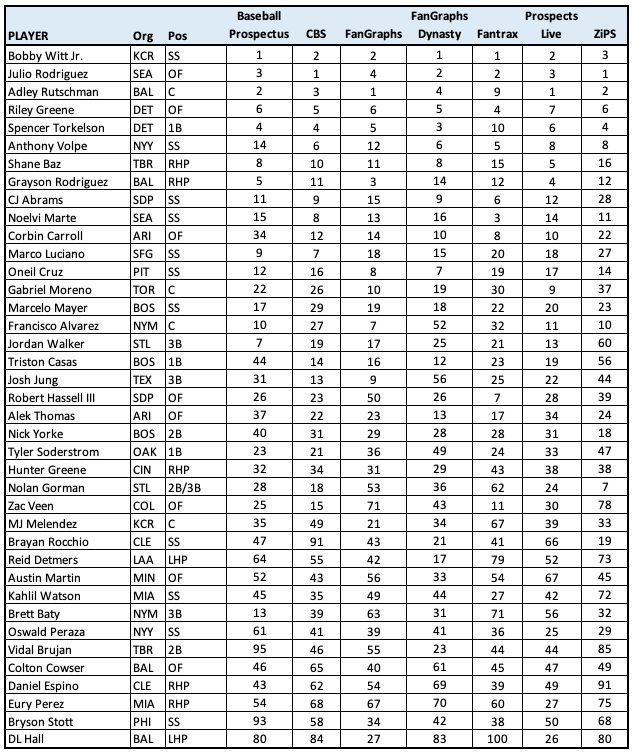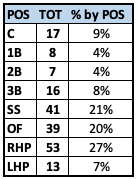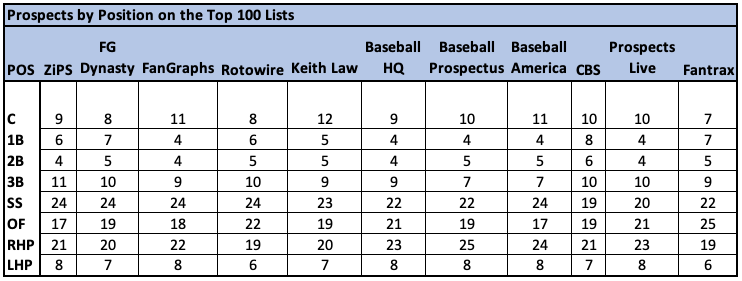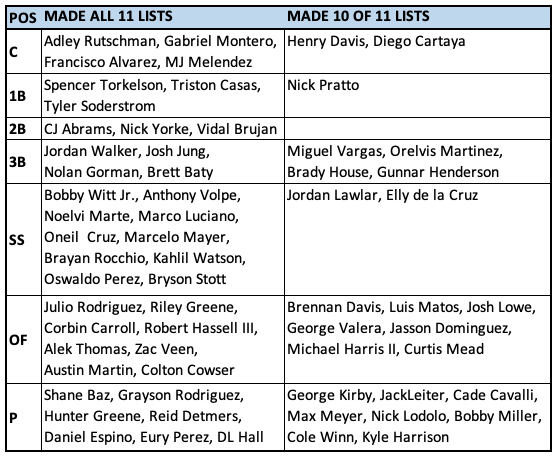Comparing and Contrasting Eleven Top Baseball Prospects Lists

Now that the owners and players have come to an agreement on a new CBA, it’s time to focus on baseball on the field instead of bargaining in the conference rooms. There should be a flurry of free agent signings in the next week or so, with some big-name veterans joining new teams. There will also be young, exciting prospects on every team in the league, some who will become the superstars of tomorrow and some who will never get past Double-A.
With baseball prospects on the mind, I did some research on the many top-100 prospects list that are out there, from the long-tenured Baseball America list to the computer-generated ZiPS list from Dan Szymborski. I have access to 11 such lists. One notable omission is the MLB Pipeline Top-100, which has not yet been updated for 2022, likely due to the lockout. Here are the lists (with links) used for this research:
Baseball America (subscription required)
Baseball HQ—fantasy focused* (subscription required)
CBS—fantasy focused*
FanGraphs Dynasty—fantasy focused*
Fantrax—fantasy focused*
Keith Law (subscription required)
Rotowire—fantasy focused* (subscription required)
Correlation Among the Top Prospects Lists
The chart below shows how each list correlates with the others. A correlation of 1.0 would show a perfect positive correlation, which isn’t going to be the case here because no two lists are going to be identical. For the most parts, these lists correlate with each other in the 0.60 to 0.75 range.

The two lists that are most correlated to each other are the CBS list and Baseball HQ, with a correlation of 0.85 (highlighted in dark green). Other highly correlated pairs include Prospects Live/CBS (0.80) and Prospects Live/Baseball America (0.79). Of all the lists, ZiPS is generally the least correlated list to the others, which makes sense because it is computer generated, while the others use a mix of data and scouting. The low correlation to the other lists is most evident with ZiPS/Keith Law (0.35), ZiPS/Fantrax (0.39), and ZiPS/BaseballAmerica (0.41).
Breakdown by Position
There are 194 players named on at least one list, with right-handed pitchers getting the most spots, as you’d expect. Shortstops and outfielders are next, followed by catchers, third basemen, left-handed pitchers, first basemen and second basemen.

Prospect lists tend to value up the middle positions (except for second basemen). Players who start out as shortstop prospects often move off of the position to second base or third base for defensive purposes. Similarly, center field prospects transition to left field or right field when they show they can’t handle center field defensively. On the other end of the defensive spectrum, a first baseman really has to rake to make a top-100 list because the offensive bar at the position is just so much higher than the others. Finally, there are relatively few second base prospects because most players who end up at second base are shortstops when they appear on a top prospects list.
Each top prospect list is its own thing, with a different collection of players. The following chart shows the positional breakdown for each of the sources. There’s a general trend for the non-fantasy baseball focused lists to have more catchers in their top 100, like Keith Law (12), Baseball America (11), Baseball Prospectus (10), and FanGraphs (10). With much of their value coming from defense, many catching prospects aren’t as desirable for fantasy baseball as they are in real life.

Cream of the Crop
Thirty-nine players were named on all 11 lists and another 24 players were named on 10 of 11. While they may have landed at different spots on their respective lists, these 63 players have near-universal agreement that they belong in any conversation about the best prospects going into the 2022 season.

Four of the prospect lists—FanGraphs Dynasty, Baseball HQ, Baseball America, and Prospects Live—include all 63 of these players. The other sources generally have 1 to 3 of these players who didn’t make the cut. The exception here is ZiPS, which doesn’t include 10 of these players. A look at the specific players who ZiPS doesn’t have in their top-100 suggests that for some it was simply limited or no data. Four of the 10 ZiPS omissions were acquired in last June’s Amateur Draft and two others were 2020 draft picks with limited track records.
Unique Players
On the flip side, there are 49 players who made just one of these 11 top-100 prospects lists. These are the players unique to each source. ZiPS led the way, with 14 such players, as shown below.
Players on just one list: 49
- ZiPS—14 players unique to ZiPS
- Prospects Live—8
- FanGraphs—7
- Baseball Prospectus—5
- Keith Law—4
- Rotowire—3
- Fantrax—3
- Baseball America—2
- FanGraphs Dynasty—1
- Baseball HQ—1
- CBS—1
The Top 10
Among the 39 players who are named on all 11 lists, there’s a top tier of three players leading the way—Kansas City Royals shortstop Bobby Witt Jr., Seattle Mariners outfielder Julio Rodríguez, and Baltimore Orioles catcher Adley Rutschman. Witt and Rutschman are both named the top prospect by four sources, with Rodríguez landing in the top spot three times. Based on a simple average of all 11 sources, Witt stands out as the best overall prospect, with an average ranking of 1.8. He also has the lowest standard deviation across sources, at 0.75, as every source ranked him first, second, or third.
Behind Witt is Rodríguez, with an average ranking of 2.7, just barely ahead of Rutschman, at 2.8. Rodríguez was ranked first or second by seven sources, third by two sources, fourth by one source, and down at ninth by one source (Keith Law, who had five up-the-middle players, a pitcher, and an outfielder ranked higher than Rodríguez). Rutschman was also ranked ninth by one source, Fantrax, whose list is specifically geared towards fantasy baseball. Fantrax has four shortstops and four outfielders ranked higher than Rutschman.
After the big three at the top, the consensus fourth and fifth-best prospects are both in the Detroit Tigers system—outfielder Riley Green (average ranking of 4.9) and first baseman Spencer Torkelson (average ranking of 5.0). Rounding out the top 10 are New York Yankees shortstop Anthony Volpe (9.0), Tampa Bay Rays pitcher Shane Baz (9.6), Detroit Tigers pitcher Grayson Rodríguez (10.0), San Diego Padres shortstop CJ Abrams (10.8), and Seattle Mariners shortstop Noelvi Marte (12.2).
Speaking of Marte, he earns the distinction of being the youngest player among this consensus top 10. He’ll play this season as a 20-year-old, likely starting the year with the High-A Everett Aquasox in a very hitter-friendly ballpark. The Mariners would love to see Marte follow in the footsteps of fellow top-10 prospect Julio Rodríguez, who hit .325/.410/.581 as a 20-year-old in High-A last year before moving up and hitting .362/.461/.546 in Double-A.
39 Prospects on All Seven Freely Available Top Prospects List
The chart below shows the rankings from the freely available prospect lists for the 39 players who appeared on every list.

Five Notable Faves and Five Notable Fades
As mentioned previously, there were 39 players who appeared on every list used for this research. While there was a general consensus on many players, there were also some players who had notable rankings both above and below the consensus ranking, which we’ll call faves and fades. To be fair, all of these players are very good young players, so the fades are within the context of being a consensus top-100 prospect.
Faves
Prospects Live Fave—RHP Eury Perez, Miami Marlins, 27th (consensus ranking—60.6).
Every source except for Prospects Live has Perez ranked between 54th and 75th. Prospects Live has him at 27th. Perez is listed at 6-foot-8 and just 200 pounds at FanGraphs, with this comment: “Built like a human skyscraper, Perez has incredible control of his limbs for a pitcher this tall, this age, who throws this hard. His ceiling is as lofty as he is.” Perez split last season between the Jupiter Hammerheads in the Low-A Southeast League and the Beloit Snappers in the High-A Central League, pitching a combined 78 innings with 108 strikeouts and a 1.96 ERA. The Marlins have developed some good pitchers recently and Perez could be better than any of them.
Baseball Prospectus Fave—3B Brett Baty, New York Mets, 13th (consensus ranking—46.5).
The next-best ranking for Baty other than Baseball Prospectus is 31st, by FanGraphs Dynasty. The Mets drafted Baty with the 12th overall pick in the 2019 June Amateur Draft and he spent most of that year in Rookie Ball. The 2020 season was a wash because of the pandemic, but Baty was back and hitting well at High-A and Double-A last year, combining for a .292/.382/.473 batting line with a 12 percent walk rate.
Fantrax Fave—OF Robert Hassell III, San Diego Padres, 7th (consensus ranking—27.7).
The Fantrax top prospect list is geared towards fantasy baseball and factors in proximity to the major leagues, upside, the farm system the player is in, and key tools. Hassell is still likely a couple years away from the big leagues, so he must make up for his relative lax of proximity to the major leagues with his upside, tools, and being on the Padres. In 2021, he was an on-base machine in A-ball, hitting .323/.415/.482 (139 wRC+) and stealing 31 bases. He wasn’t as good in 18 games in High-A (.205/.287/.410, 89 wRC+), but there’s a ton of talent here.
Keith Law Fave—RHP Hunter Greene, Cincinnati Reds, 12th (consensus ranking—32.6).
While Law has Greene 12th on his list, every other source has him ranked between 26th and 43rd, which is a relatively low standard deviation. Greene is a 6-foot-5, 230-pound righty with a fastball that has been clocked as high as 104 mph in games. He was the Reds first-round pick out of Notre Dame High School in 2017, but his career went on hiatus after Tommy John surgery in 2018. That resulted in a lost 2019 season, followed by the 2020 pandemic year without minor league baseball. He returned last season to strike out 139 batters in 106.3 innings across Double-A and Triple-A. The Reds traded away Sonny Gray last week, so Greene is expected to get significant major league innings this year (projected to make 17 starts by ATC projections at FanGraphs).
ZiPS Fave—2B/3B Nolan Gorman, St. Louis Cardinals, 7th (consensus ranking—33.1).
Dan Szymborski’s ZiPS projection system is a big fan of Nolan Gorman, who has been a better-than-average hitter in every minor league stop but one since being drafted by the Cardinals in the first round of the 2018 Amateur Draft. Gorman was drafted as a third baseman, but the acquisition of Nolan Arenado pushed him to second base last season and he should be playing in St. Louis sometime this summer.
Fades
Keith Law Fade—SS Oneil Cruz, Pittsburgh Pirates, 65th (consensus ranking—17.8).
Law is by far the low person on Cruz, ranking him 65th. Every other source has Cruz ranked 19th or better. FanGraphs and FanGraphs Dynasty have him ranked 8th and 7th, respectively. In his write-up at The Athletic, Law points out that the odds of the 6-foot-7 Cruz remaining at shortstop are heavily against him. When he appeared in a game for the Pittsburgh Pirates last September, Cruz became just the second player 6-7 or taller to play shortstop in a major league game. Even if he doesn’t stay at short, his bat should play anywhere.
ZiPS Fade—3B Jordan Walker, St. Louis Cardinals, 60th (consensus ranking—23.9).
ZiPS is a big fan of one St. Louis third base prospect, Nolan Gorman, but not such a big fan of another, Jordan Walker. The other sources all have Walker ranked 30th or better, with Baseball Prospectus ranking him 7th. To be fair to ZiPS, the computer program only has one year of professional data to go by, as Walker was the Cardinals 1st round pick in 2020. His .317/.388/.548 triple-slash in A and High-A last year was good enough to put him on this list, which is still quite impressive even if the other sources like him better.
CBS Fade—SS Brayan Rocchio, Cleveland Guardians, 91st (consensus ranking—43.5).
The 77-spot difference between CBS ranking Rocchio 91st and Rotowire ranking him 14th is the second-largest among the 39 players who appeared on every prospect list. After being an above-average hitter in Rookie ball, Low-A, High-A, and Double-A so far in his career, Rocchio should play the bulk of his time in Triple-A this year and has a shot to reach the major leagues late in the season. CBS has him ranked this low because his fantasy outlook for 2022 is not as high as others on their list.
Keith Law Fade—SS Oswald Peraza, New York Yankees, 95th (consensus ranking—50.5).
Peraza is ranked all over the place by the different sources. Law has him at 95. He’s 74th on the Baseball HQ list, 61st at Baseball Prospectus, in the 50s at Baseball America and Rotowire, and in the 20s at Prospects Live and on the ZiPS list. Law expects Peraza to be a 20-plus homer guy with plus defense, but his plate discipline needs improvement to make him above-average in the on-base department.
Rotowire Fade—3B Brett Baty, New York Mets, 91st (consensus ranking—46.5).
Baty makes it on the list of notable faves and notable fades with a contrasting ranking of 13th by Baseball Prospectus and 91st by Rotowire. That 78-spot difference is the largest among players named on every list, just beating out the aforementioned Brayan Rocchio. Baty is ranked in the teens, the 30s, the 40s, the 50s, the 60s, the 70s, and the 90s.
















